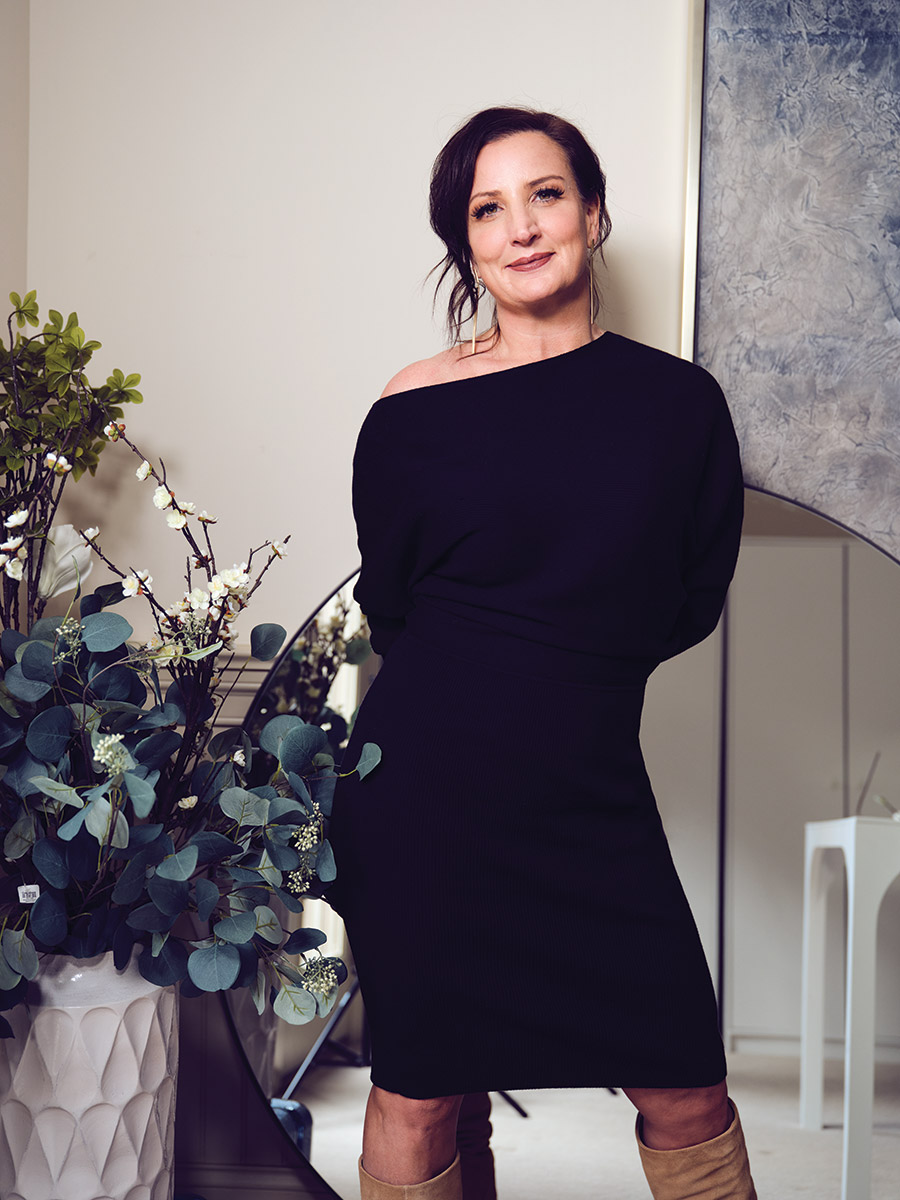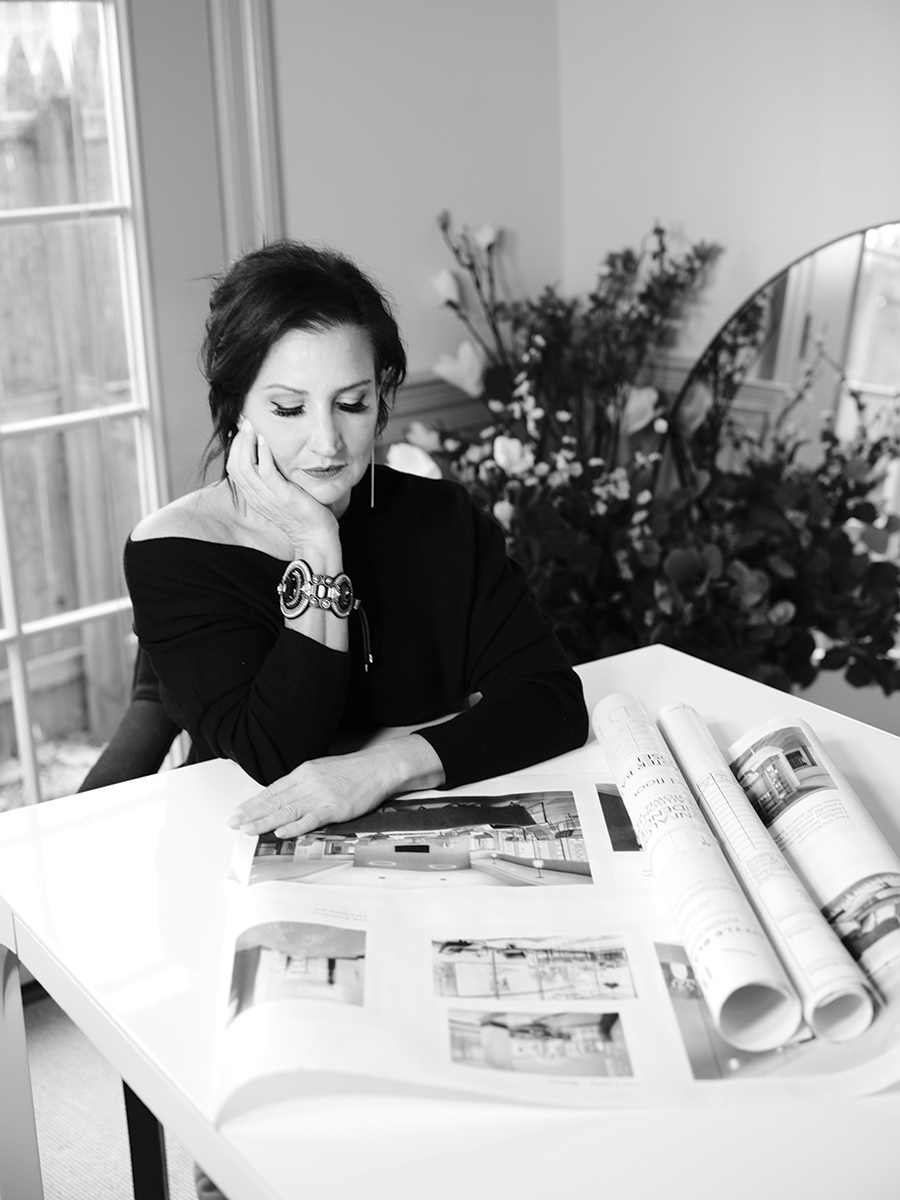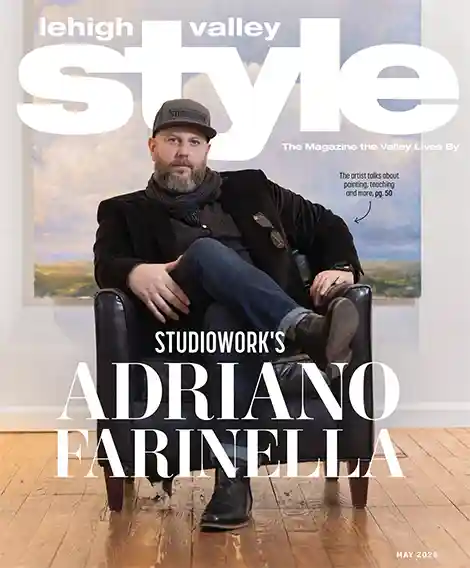Think about the last medical office you visited. What color were the walls? What did the furniture look like? How would you describe the décor? If you're drawing a blank, don't fret. It's not often that these types of places make a lasting impression. White walls, worn carpeting and humdrum chairs and couches seem to be the norm: bland, at best; downright dreary, at worst. But maybe there's a different way. A better way. Just ask Linda Magnavita, founder and owner of Little Black House, an interior design studio based in Philadelphia. Last year, her team completed an overhaul of the Aether Medicine office in Wayne. The finished product is bright, bold and welcoming—think boutique hotel, rather than drab health center. “It's like nothing you've ever seen,” says Magnavita. In short, if you're one of the practice's patients, you might actually enjoy spending time in the space, rather than counting down the seconds until your appointment is over.
Magnavita has always had a flair for the creative, although it took a little time to figure out how to best cultivate those budding aspirations. “I was always obsessed with design. I just never put the two together [as a career],” she says.
She moved to Allentown with her family when she was in kindergarten. She first attended Central Elementary School and then Raub Middle School.
As a child, she was a gymnast and a cheerleader and developed an interest in the visual and performing arts. She recalls making many trips to the Allentown Public Library and checking out book after book from the art section. Her drawings and paintings won awards. Magnavita moved away from the Lehigh Valley for high school, and then, soon after graduation, enrolled at New York City's American Mime Theatre to study the performing arts.
Magnavita found herself consumed by the omnipresent eye candy of the big city; she describes herself as “obsessed” with interiors. “It was the height of the restaurant scene,” she says. “You could start to see all of the design elements [in the buildings]. I can remember walking around the city and peeking in windows and thinking, ‘look at that lighting, look at that floor.' That was when it all clicked.” Magnavita decided a change in vocation was needed (another realization: “I didn't want to be a starving actress,” she says). But there would be one more stop before she went all-in on design: business school. She recalls watching the movie Wall Street and being taken with the fast-paced, high-stakes action that plays out on the stock exchange floor. She enrolled at Kutztown University but admits now the change in focus wasn't a good fit. Still, lessons learned in the business and financial realm would come in handy later.


She transferred to Beaver College (now Arcadia University) in Glenside her senior year, and that's where she says she finally felt at home: “My gosh, why didn't I do this earlier?” She earned her Bachelor of Fine Arts degree in interior design and found work right after graduation as a junior designer with Styer & Associates in Norristown. She was heavily involved in one of the studio's biggest gigs in 2002, getting the brand-new Lincoln Financial Field in South Philadelphia ready for its high-profile tenants, the Philadelphia Eagles. Styer & Associates was in charge of all of the FF&E (furniture, fixtures and equipment) at the stadium, everything from then-coach Andy Reid's desk to the trash cans surrounding the field to the locker rooms used by the players.
In 2003, Magnavita joined the studio of Main Line interior designer Barbara Gisel, which specializes in high-end homes. “I got to see the crème de la crème of residential interiors,” she says. She also got to put her talents to work in Sin City, when the studio took on an interior design project at Caesar's Palace Hotel and Casino on the Las Vegas strip. But Magnavita says the end game was always establishing a design studio of her own. “I knew I was never going to grow my own style unless I worked for myself,” she says.
In 2006, she did just that, with the founding of Little Black House. But the decision to strike out on her own didn't spark any of the second-guessing and jitters that sometimes can accompany such a bold move. “I'm a risk taker,” says Magnavita. “It was exciting and fun.” It also probably helped that she's not averse to change. “I encourage it,” she says. “I get so bored with things.” She started small, first operating the business out of her home before moving into a space in Allentown's Cigar Factory Artist Studios building in 2018. Two years later, Little Black House relocated to its current home in the upscale Chestnut Hill section of Philadelphia.
Magnavita leads a team of four with a goal of creating unique interiors that inspire and excite. She likens a successful design to combining all of the ingredients for a new recipe. “Every project has multiple tasks and although the process is always the same, the end result is always different,” she says. “Seeing it come together is incredibly satisfying!” Little Black House's portfolio includes work across the residential, hospitality and commercial sectors. The studio's overall style might be described as bold, simple and fresh, an approach that transcends traditional. And of course, every project presents its own unique set of opportunities and challenges. “It's never about me,” says Magnavita. “It's always a collaboration between the client and myself. When clients let us get to know them, amazing things can happen.”
She also believes design, when executed properly, can truly impact lives. “It's an experience,” Magnavita says. “Design can create so many different feelings for people.” She cites the Aether medical office as an example of how a carefully constructed interior can build upon its utilitarian function. “The owner was interested in creating a space that was fun, functional and fashionable. Those were the three words he gave me,” says Magnavita. The office blends elements of the natural world with shades of blue to conjure up the calming effects of the ocean and promote an atmosphere of healing.
Another recent project was the Nailplay Studio in Downtown Allentown, with a black-and-white color scheme that was sparked by the building's concrete floors, which Magnavita insisted remain as part of the finished product. The design combines industrial, modern and masculine elements, but Magnavita says the goal was crafting an interior that promotes a welcoming, spa-like vibe. A long communal table in the center of the salon is meant to invite conversation, an experience similar to sitting around the dining room table with family. “It's this community moment for everyone, to be fun and playful,” Magnavita says.
You can be sure there's much more to come from Little Black House. And LBH likely won't remain “little” for much longer, if Magnavita has her way. She envisions moving her team to a bigger space and bringing nearly a dozen more designers into the fold. “The only way is up for us,” she says.
Published as "Insight" in the March 2022 edition of Lehigh Valley Style magazine.
















